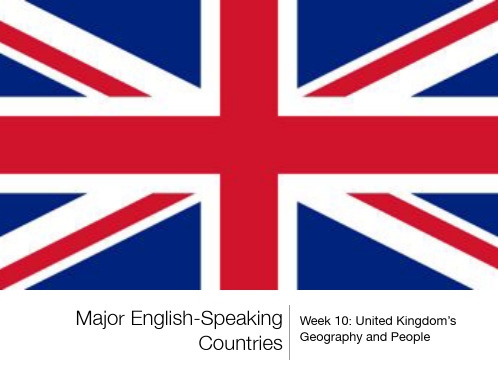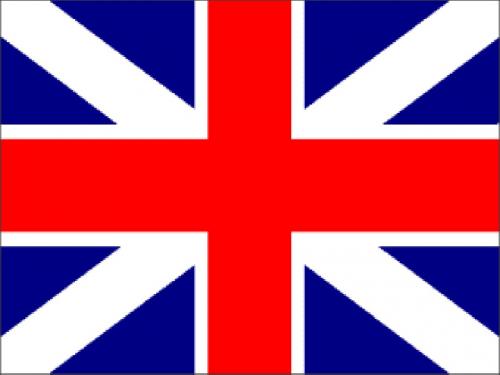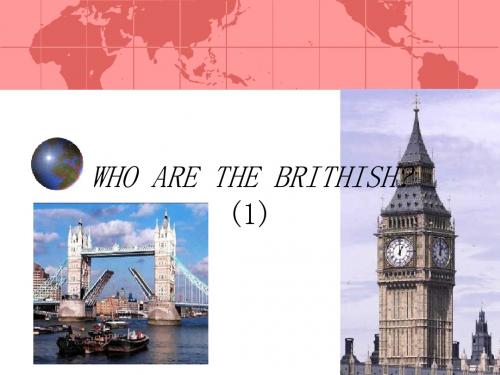UK简介~
- 格式:ppt
- 大小:10.55 MB
- 文档页数:23

英国皇家物流与运输学会(CILT(UK))简介英国皇家物流与运输学会(INSTITUTE OF LOGISTICS AND TRANSPORT,简称CILT(UK))是在1999年6月由两所具有百年历史的英国物流学会和英国运输学会合并而成。
英国女皇伊丽莎白二世亲自为学会的成立签署了皇家令状(ROYAL CHARTER)。
安妮公主(Her Royal Highness The Princess Royal)是学会的皇家赞助人(ROYAL PATRON),曾任学会名誉主席。
学会历任总裁均为英国物流运输著名人士或高级官员,如英军负责后勤的副总参谋长格兰休尔将军等。
CILT(UK)是世界上最早、最权威的物流与运输专业组织之一。
在近百年的发展历程中,形成和完善了全球领先的一整套完整的物流和运输职业资质标准和认证体系,其认证标准及相应课程被欧洲、北美、亚洲、大洋州和非洲的众多国家广泛采用,例如澳大利亚、加拿大、新西兰、爱尔兰、阿联酋、新加坡、印度、马来西亚、中国香港特区、南非等。
在英国,更有35所著名大学开设由ILT批准的有关物流和交通运输的学士、硕士及博士课程。
CILT(UK)物流证书还得到了其他国际专业组织和著名学府的广泛承认,如国际物流学会、欧洲物流认证委员会等,英国物流与运输专业著名大学如CRANFIELD、ASTON等大学承认CILT(UK)证书作为其硕士学位学分。
CILT(UK)物流职业证书是由CILT(UK)设计的一整套系统的物流专业人员证书体系,分为四个级别:一级:物流人员基础证书;二级:物流部门经理证书;三级:物流运营经理证书;四级:物流战略经理证书。
CILT(UK)证书的认证标准是基于各个级别的物流专业管理人员所应具有的能力模型设计的,其认证考试也是从两个方面对考生进行考核,即专业知识和实际工作能力,并侧重强调实操能力的考核。
北京中交协物流人力资源培训中心(CLTC)是CILT(UK)物流认证在中国唯一的总执行机构,负责CILT(UK)物流认证在中国的考试、组织、质量监控及CILT(UK)标准当地化。





A Brief Introduction of the United KingdomThe full name of the country is the United Kingdom of Great Britain and Northern Ireland. It is a complicated name for what is in many ways a complicated country. There’re four parts, England, Scotland, Wales and Northern Ireland, which complete to the set.Here, as follows, are a few aspects of the United Kingdom.1. PoliticsThe Government of the United Kingdom(1) The MonarchyThe oldest institution of government is the Monarchy cruel by the king. This dates back to the Saxon who ruled from the 5th century AD until the Norman Conguest in 1066.The power of the monarchy was largely derived form the ancient doctrine of the ‘divine right of kings”. It was held that the sovereign derived his authority from God, not from his subjects.While the king in theory had God on his side, in practice even in medieval times it was thought that he should not exercise absolute power.(2) The ParliamentThe word “parliament”comes from the verb “the parley”, that is to discuss or talk. The term was first used officially in 1236 to describe the gathering of feudal barons and representatives from countries and towns which the occasionally summoned if he wanted to raise money.The Great Council came to include both those who were summoned “by name”(the House of Lords) and representatives of communities (the House of Commons). These two houses exist today and collectively we call them the parliament. The Commons quickly gained in political strength. They were willing to help the king by raising taxes and passing laws, but in return they wanted an increasing say in what the king was doing.The parliament became the most powerful institute in Britain was after the Revolutional War.Parliament has a number of different functions. First and foremost, it passes laws. Another important function is that it provides the means of carrying on the work of government by voting for taxation. Its other roles are to scrutinize government policy, administration and expenditure and to debate the majority issues of the day.Parliament is supreme in the British state because it alone has the power to change the terms of the constitution.There are no legal restraints upon parliament. It can make or change laws. Change or overturn established conventions or even prolong its own life withoutconsulting the electorate. However, it does not assert its supremacy, but bears the common law in mind and acts according to precedent..Each Parliament lasts for 5 years.The Upper house has no right to decide, it only has the right to pass the bills passed by the Lower House.The party which holds a majority of those “seats”in parliament forms the government, with its party leader as the Prime Minister. After a government has been in power for 5 years it has to resign and hold a “general election”, in which al British adults are give the chance to vote again for their constituency’s MP. A government cannot stand for longer than 5years except in exceptional circumstances. However, the Prime Minister can call an election sooner than 5years. This can happen when the government loses a “vote of no confidence” in the House of Commons. That is, an MP puts forward a statement for the MPs to vote on saying that “This house no longer ha confidence in the government.”(3) The Political PartiesThere are three major national parties: The conservative party and the Labour party are the two biggest, and any general election is really about which of those two is going to govern. But there’s a third important party, the Liberal Democrats, who usually receive up to about 20% of the votes: not enough to form a government, but enough to have a big impact on which of the other two parties does so.The Labour party is the newest of these three, created by the growing trade union movement at the end of nineteenth century. It quickly replaced the Laberal party as one of the two biggest parties. Labour is a socialist party. That is to say that they believe a society should be relatively equal in economic terms, and the part of the role of government is to act as a “redistributive” agent. The Conservative party is the party that spent most time in power, basically the Conservative are seen as the party of the individual, protecting the individual’s right to acquire wealth and to spend it how they choose , and so favouring economic policies which businessmen prefer, such as low taxes. They receive a lot of their party funding from big companies.2. Religion(1) Queen or king is the leader as well as the bishop of the High Church.(2) 20% of British citizen claims to be Roman Catholics.(3) 40% of Scotland citizen believe in Roman Catholic.(4) Two established churches: Church of London; Church of Scotland.(5) Roman Catholic churches.(6) Free Churches.3. CultureHere, I will emphasis on one aspect of Britain’s artistic output, that for which it is perhaps best known: Literature.⑴Early WritingMuch early British writing was concerned with Christianity: Anglo-Saxons produced beautifully illustrated versions of the Bible: the most famous of these is the book of keels, party written on the Scottish island of lona.⑵Elizabethan DramaThere was a general flowering of cultural and intellectual life in Europe during the 15th and 16th centuries which is known as “The Renaissance”, in British culture one of the most successful and long-lasting expressions of this development lay in drama.⑶18th –century English literature is marked by a rather large shiftfrom the mood and tone of 17th –century literature.⑷The Romantic PeriodRoughly the first third of the 19th century makes up English literature’s romantic period. Writers of romantic literature are more concerned with imagination and feeling than the power of reason, which marked the 18th century.⑸20th Century LiteratureThe 20th Century marked the end of the British Europe, which was replaced by the Commonwealth of Nations. Yet English civilization and culture continue to have a strong influence on the rest of the world. The heritage of English literature forms an outstanding part of that culture.20th Century literature can be broadly divided into two stylistic periods: Modernism, and Postmodernism. These periods roughly correspond to literature written after it. Both are characterized by a high degree of experimentation.4. EconomyNational economies can be broken down into three main areas: “primary”industries, such as agriculture, fishing and mining, “Secondary”industries, which manufacture complex goods from those primary products; and tertiary industries, often described as services, such as banking, insurance, tourism, and the selling of goods.Britain’s agricultural sector is small but efficient, producing 58% of the UK’s food needs with only 2% of its workforce. Three quarters of Britain’s land is used for agriculture, with about a quarter of that under crops-wheat and barley are the two commonest. The rest is grazing for animals.The fishing industry provides 55% of the UK demand for fish. Scottish ports land the majority of the fish caught.Energy production is an important part of the UK economy, accounting for 5% of the national wealth.In the secondary sector of the economy, manufacturing industry remains important, producing 22% of national wealth.The service sector of the United Kingdom is dominated by financial services, especially in banking and insurance. London is one of the world’s largest financial centers with the London Stock Exchange, the London international Financial Futures and Options Exchange, and the Lloyd’s of London insurance market all based in the city. It also has the largest concentration of foreign bank branches in the world. 5.British diplomatic affairs(1)Britain’s foreign policies:The contemporary foreign policy of the UK is greatly influenced by its imperial history and also by its geopolitical traits. Perhaps the most important single factor which influences British policy-makers is its history.A second decisive influence upon the way Britain conducts its external affairs is geopolitical. Britain is an island state, and this is considered an important psychological factor as well as one which has influenced Britain’s economic and military development as a nation of seafarers who roamed the globe looking for territory and economic opportunities.How these foreign policies made:The general direction of Britain’s foreign policy is mainly decided by the Prime Minister and Cabinet. The main government department is of course the Foreign and Commonwealth Office, but many other government ministers also play a part in formulating and executing the government’s decisions.The Ministry of Defence is responsible for ensuring Britain’s defence and managing Britain’s involvement in its military treaty commitments. And the Department of Trade and Industry is for the international trade policy and British commercial relations with other countries.(2)Britain and International Institutions:Nowadays its foreign policy is largely shaped by its participation in a number of important international institutions.Britain is one of the five permanent members of the United Nations Security Council, along with Russia, China, the Us and France. It is also the sixth largest contributor to the UN’s budget. As a Security Council member, Britain retains the ability to have a large influence on world affairs. And the more important to Britain today in running of its affairs is its membership in the EU. Britain is also a member of the Commonwealth. Even though Britain granted its colonial territories independence, it continued to feel close to these new countries and wanted to continue to work with them.(3)Security and Defence Policy:Britain depends more on defence than most other advanced industrial countries and maintains larger professional forces. The keystone of British defence policy is its participation in NATO, which is commonly known as the North Atlantic Treaty Orgnasition. In addition to its NATO commitments, Britain retains an independent nuclear weapons capability but it is highly unlikely for it to use, or need to use the capability.。
globepay(uk)的介绍
摘要:
一、Globepay(uk) 简介
1.成立时间
2.所在地
3.主要业务
二、服务内容
1.在线支付
2.移动支付
3.电子钱包服务
三、客户群体
1.个人客户
2.企业客户
3.金融机构客户
四、合作银行与金融机构
1.合作伙伴遍布全球
2.提供便捷的支付方式
五、增值服务
1.风险管理
2.欺诈检测
3.数据分析
正文:
Globepay(uk) 是一家英国的在线支付公司,成立于2005 年。
该公司总部位于英国,主要业务包括在线支付、移动支付和电子钱包服务。
它的客户群体广泛,包括个人、企业和金融机构。
作为一家领先的在线支付公司,Globepay(uk) 通过与全球各地的银行和金融机构合作,为消费者提供便捷、安全的支付方式。
无论是在线购物、跨境支付还是移动支付,Globepay(uk) 都能满足客户的需求。
此外,Globepay(uk) 还提供了一系列增值服务,如风险管理、欺诈检测和数据分析。
这些服务旨在帮助客户降低交易风险,提高交易效率。
globepay(uk)的介绍
(原创实用版)
目录
1.Globepay(UK) 简介
2.Globepay(UK) 的业务范围
3.Globepay(UK) 的优势
4.Globepay(UK) 的支付解决方案
5.Globepay(UK) 的合作伙伴
6.Globepay(UK) 的展望
正文
1.Globepay(UK) 简介
Globepay(UK) 是一家在英国注册的金融科技公司,致力于为企业提供全球范围内的支付解决方案。
该公司拥有丰富的行业经验和专业的技术团队,以高效的服务和创新的技术为客户创造价值。
2.Globepay(UK) 的业务范围
Globepay(UK) 的主要业务范围包括支付解决方案、外汇兑换、虚拟卡发行等。
其服务覆盖全球多个国家和地区,为各类企业提供安全、便捷的支付服务。
3.Globepay(UK) 的优势
Globepay(UK) 拥有如下优势:首先,其支付解决方案可以满足各种规模和类型的企业需求;其次,其拥有高效的运营团队,可以为客户提供24/7 的全天候服务;最后,其与多家国际金融机构合作,可以提供具有竞争力的汇率和低廉的交易费用。
4.Globepay(UK) 的支付解决方案
Globepay(UK) 的支付解决方案包括在线支付、移动支付、跨境支付等多种形式。
其平台支持多种主流的支付方式,如信用卡、借记卡、支付宝、微信支付等,可以满足各类客户的支付需求。
5.Globepay(UK) 的合作伙伴
Globepay(UK) 的合作伙伴包括国际知名金融机构、电商平台、旅游公司等。
其合作伙伴遍布全球,可以为客户提供广泛的业务支持和资源共享。
Why do we study history when studying culture?History tells us:the context of the culturedifferent cultural influences from the pastdifferent linguistic influencesinformation that may help us better understand that culture’s taboos, stereotypes, etc.about what that culture’s “common knowledge” isEngland FactsCapitol: LondonGovernment: Constitutional Monarchy and Parliamentary SystemPopulation: 53 Million (84% of UK)Main Language: EnglishReligions: Christianity (59.4%), Non-Religious (24%), Musilim (5%), Other (10.9%)Originally comprised of tribal kingdoms of Celtic peoplesInvaded by Romans and became part of Roman Empire; When Romans left, split into many small kingdoms Invaded by Angles and Saxons (Germanic), and unified by Anglo-Saxon legend King Arthur; Anglo-Saxons incorporated into or dominated Celtic EnglandInvaded by Vikings (Scandinavian); Vikings defeated by King Alfred the GreatInvaded by Normans (French); William the First reigned and next 300 years were basically Norman-ruled (Robin Hood)These legends become important parts of England’s cultural identityAfter Norman invasion, gradual joining together of the British Isles to form a wider British identityThis united the kingdom inside and presented single British identity to the world outsideEngland became an imperial power, spreading its dominion over several countries and continentsEngland continues to be an influential country in the worldEngland: Points to RememberEarly England was continually invaded by many different types of peoples and had to constantly reinvent itselfEnglish people today are comprised of Celtic, Anglo-Saxon, Viking, and Norman ancestry (at least!)English legends reflect part of England’s cultural identity: external conformity concealing a richly unconventional interiorOriginally comprised of tribal kingdoms of Celtic peopleHas spent a long time independent of other countries in the UK and has a strong self-identityRomans tried to invade Scotland but failed: Romans succeeded in invasion to modern Scottish-English border, then Romans build Hadrian’s Wall (much like China’s Great Wall) to mark their territory Traditional Celtic people displaced by Anglo-Saxons from the southeast and Northern Irelanders (“Scots”) from southwest to harsh Highlands; threat of invasion from Scandinavian Vikings and Anglo-Saxon England Joined union when James VI of Scotland took English throne, but many rebellions followed; still a strong sense of nationalismWales: HistoryOriginally comprised of tribal kingdoms of Celtic peopleDominated by England for the longest compared to other countries in UKOriginally inhabited by Celtic tribal kingdomsRetains its mother tongue, Welsh (19% of population fluent)Invaded by Normans (French) per England’s permission, putting pressure on the country to join the union Wales unified as a country to resist England, but was unsuccessfulMany unsuccessful attempts to rebel against EnglandScotland and Wales: Points to RememberScotland:Same original ancestry and tribal structure as rest of UK (Celtic)Pressure from many different geographic points to yieldDid not yield to Romans and value themselves as strong and self-sufficientHarsh and beautiful geographyWales:Same original ancestry and tribal structure as rest of UK (Celtic)Close proximity to England meant difficulty to remain independentMany different rebellions against EnglandStrong unified cultural identity, including mother tongue“Great Britian” is the geographical term for the island comprised of England, Scotland,and Wales. “Ireland” is the geographical term for the island comprised of Northern Ireland and the Republic of Ireland.Northern Ireland: HistoryOriginally comprised of tribal kingdoms of Celtic peopleNot invaded by Romans or Anglo-Saxons: most direct descendants from Celtic ancestorsSmallest of the 4 countries in UKOriginal population was Catholic, but English Queen Elizabeth I gave Northern Irish lands to Protestant settlersNew English settlers ethnically and religiously different than indigenous Irish, causing friction especially in the northEngland encouraged English settlers to move to the north of the island to quiet down the unrest; this caused more unrestNorthern Ireland: History cont./Points to RememberNortheastern Ireland developed a population where the majority saw themselves as British subjects, and Northern Ireland partitioned off from Ireland and became part of UKNorthern Irish minority (ethnically Irish and religiously Catholic) saw themselves as different than British (ethnically Anglo-Saxon/Norman and religiously Protestant) and did not want to be part of UK Political unrest has dominated since, with bloody conflict coming from both sides“Great hatred, little room” - W.B. YeatsUnited KingdomAll 4 countries in UK share common, distant, Celtic ancestryEngland is the dominant countryEngland has a long history of being invaded by many different invadersEnglish people have mixed ancestry and now have an ethnically diverse populationScotland, Wales, and Northern Ireland have all tried to rebel against England throughout history (unsuccessfully) but now have their own quasi-independent parliaments and parliamentary presence in English parliamentHomeworkRead Units 8 and 10 in the textbookDo questions about “Remember the Titans” to be turned in next weekWatch the movie “Braveheart” (available on ZJNU’s internet library) and answer the following questions (200 words minimum each question):“Braveheart” Questions1) How does William Wallace’s national identity influence the choices that he makes throughout the movie?2) How are countries other than Scotland represented in the film?3) If William Wallace were alive today, how would he feel about Scotland being a part of the United Kingdom?Please watch the movie "Remember the Titans" and answer the following questions. Please write your answers on big paper, 120-150 words for each question. Don't forget your student number, English name and Chinese name on the top of your paper. You will hand in at the beginning of next class.1. List three characters who are treated as "the other" at some point in the film. Describe what happens that lets you know they are different in some way.2. Describe how Coach Boone encourages communication to help the players get to know each other. Give specific examples.3.What did the students on the football team discover that they had in common, despite the differences they thought existed between them at first? Give specific examples of communication that lead to this understanding.4. Give 3 examples of communication where one character uses language to distance themselves from another character.Give 3 examples of communication where one character uses language to make themselves more similar or point out similarities with another character.5. Give two examples of friendships or relationships that are formed despite the previous feeling of "the other" that existed between the two people.。